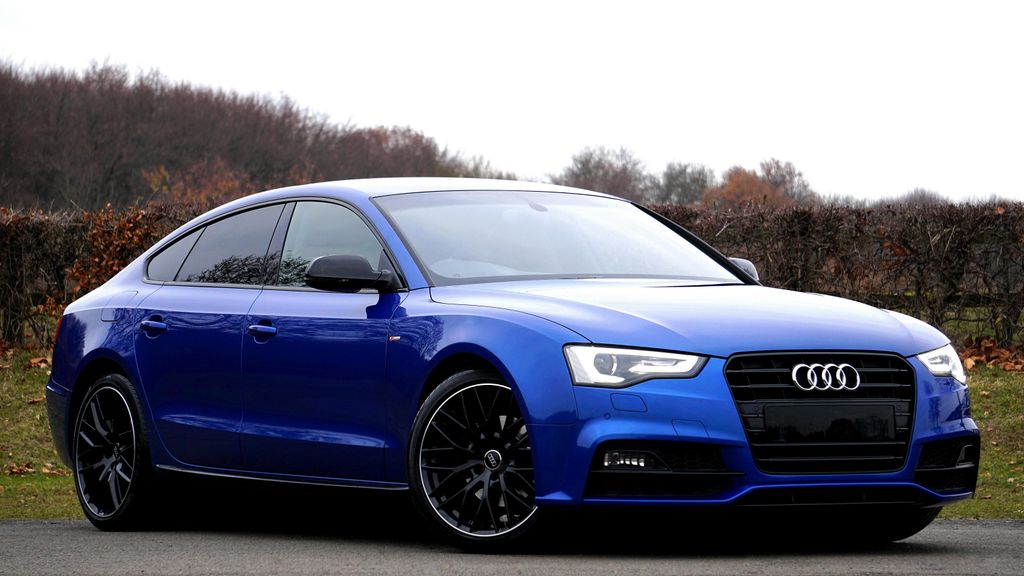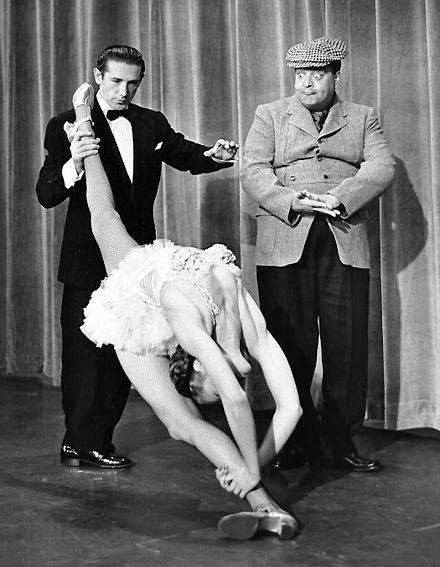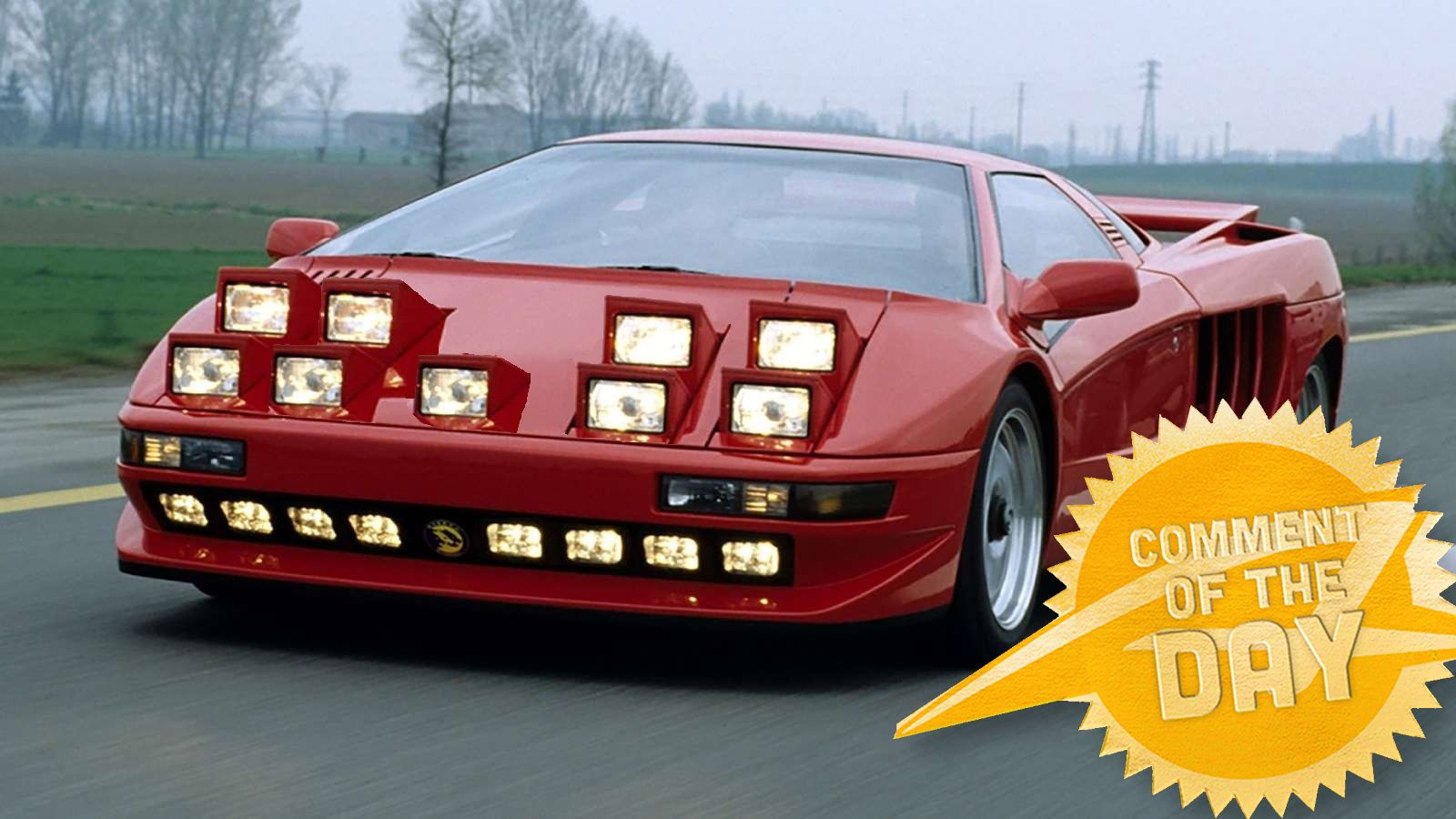
They blinked, they flipped – they gave your ride a face and attitude to match. Pop-up headlights, also known as retractable headlights, were peak ‘80s cool and defined an era of automotive design where cars weren’t just transport; they were characters. From the sleek Ferrari Testarossa to the humble Mazda Miata, these hideaway lights were a defining feature of some of the coolest cars of the 70s, 80s, and 90s.
One day, they were everywhere, winking from the hoods of sports cars and JDM heroes. The motion of the headlights popping up felt mechanical, even theatrical. You’d turn the lights on and feel like something was happening. You weren’t just driving a car – you were piloting a machine with personality. But then, almost overnight, they vanished, leaving a void that modern, sleek LED strips can’t quite fill.
But have you ever truly wondered where these beloved retractable headlights went? This wasn’t a slow fade, but a dramatic disappearance, driven by a confluence of evolving regulations, technological advancements, and shifting design priorities. While their mechanical charm and distinctive reveal are sorely missed by enthusiasts, the reasons for their departure are deeply rooted in the relentless march of automotive progress. Let’s take a nostalgic journey back to the golden age and celebrate some of the most iconic vehicles that wore their pop-ups like a badge of honor, exploring the magic they brought to the road.
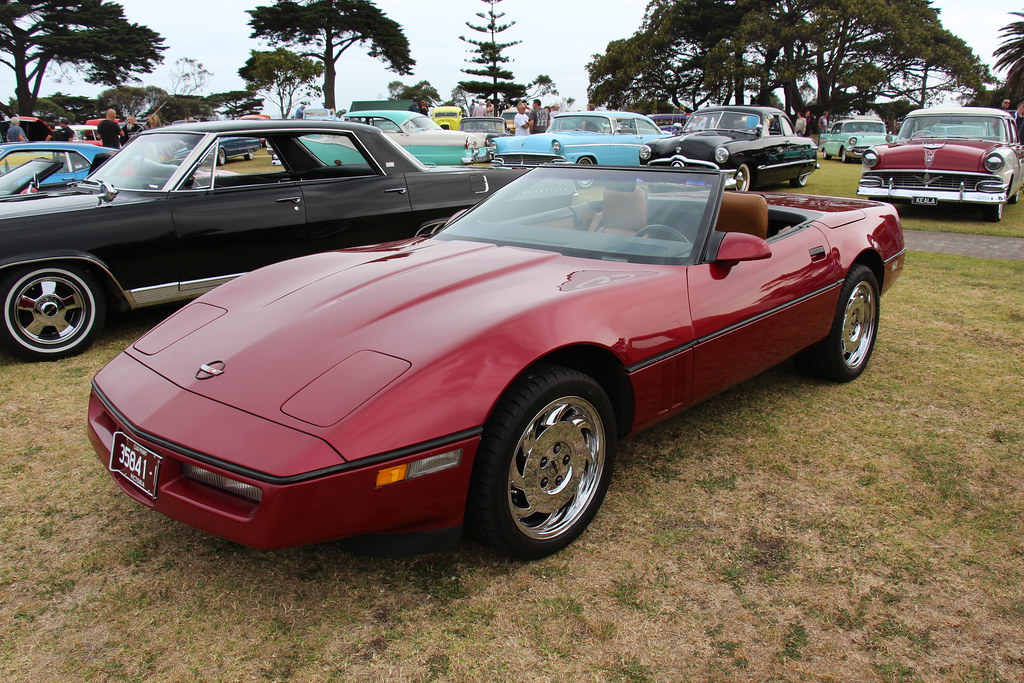
1. **Chevrolet Corvette C4**The Chevrolet Corvette C4 stands as a quintessential American classic, and its pop-up headlights were undeniably a signature feature that elevated its allure. Introduced in 1984, the C4 was a radical departure from its predecessors, embracing a sleek, modern aesthetic that perfectly encapsulated the spirit of the era. Its retractable headlights weren’t just a design choice; they were integral to the car’s streamlined profile, allowing for a lower, more aggressive front end when the lights were tucked away.
This generation of the Corvette truly cemented pop-up headlights as a symbol of performance and style, making them highly desirable among car enthusiasts. When activated, the lights would dramatically emerge from the hood, transforming the car’s demeanor from stealthy cruiser to assertive sports machine. This interactive element made every drive an event, turning a simple flick of a switch into a moment of theatrical anticipation.
The C4’s design benefited significantly from its hidden headlamps, contributing to both its visual appeal and its aerodynamic efficiency. By reducing drag when the lights were off, the C4 could achieve better performance and fuel efficiency, a crucial factor for a vehicle aiming to blend high-performance with everyday usability. This blend of form and function made the pop-up headlights on the Corvette C4 not just cool, but genuinely smart in their application, proving that style didn’t have to come at the expense of engineering.
Like many vehicles of its time, the Corvette C4, and earlier models, also came to symbolize the mechanical complexities inherent in pop-up designs. As the context playfully suggests, these cars could sometimes offer an “excuse for electrical gremlins.” This aspect, while a minor frustration for owners, only added to the car’s unique personality and the shared experiences within the enthusiast community, cementing its place in the pop-up hall of fame.
Car Model Information: 2023 Honda Civic EX
Name: Chevrolet Corvette (C4)
Caption: 1994 Chevrolet Corvette
Manufacturer: Chevrolet
Production: January 3, 1983 – June 20, 1996
ModelYears: 1984–1996
Predecessor: Chevrolet Corvette (C3)
Successor: Chevrolet Corvette (C5)
Class: Sports car
Assembly: Bowling Green, Kentucky
BodyStyle: targa top,Convertible (car)
Layout: Front-engine, rear-wheel-drive layout#FMR
Platform: GM Y platform
Wheelbase: cvt
Length: cvt
Width: cvt
Height: Coupe: {{cvt,46.7,in,mm
Transmission: automatic transmission,Overdrive (mechanics),GM 4L60-E transmission,ZF Friedrichshafen
Engine: {{cvt,350,cuin,L,1,Chevrolet small-block engine (first- and second-generation)#L83
Weight: cvt
Designer: Jerry Palmer
Related: Callaway Cars#C4 (RPO B2K Callaway Twin Turbo Corvette),Callaway Cars#C4 (RPO B2K Callaway Twin Turbo Corvette),Callaway Cars#C4 (RPO B2K Callaway Twin Turbo Corvette),Callaway Cars#C6 (Callaway SuperNatural Corvette),Callaway Cars#C4 (RPO B2K Callaway Twin Turbo Corvette)
Categories: 1990s cars, All articles with dead external links, All articles with unsourced statements, Articles with dead external links from November 2016, Articles with permanently dead external links
Summary: The Chevrolet Corvette (C4) is the fourth generation of the Corvette sports car, produced by American automobile manufacturer Chevrolet from 1983 until 1996. The convertible returned, as did higher performance engines, exemplified by the 375 hp (280 kW) LT5 found in the ZR1. In early March 1990, the ZR1 would set new records for the highest average speed over 24 hours at over 175 mph (282 km/h) and highest average speed over 5,000 miles at over 173 mph (278 km/h). With a completely new chassis, modern sleeker styling, and other improvements to the model, prices rose and sales declined. The last C4 was produced on June 20, 1996.
Get more information about: Chevrolet Corvette (C4)
Buying a high-performing used car >>>
Brand: Chevrolet Model: Corvette C4
Price: $23,541 Mileage: 56,979 mi.
Read more about: Kings of the Asphalt: Reliving the Glory Days of 1980s Sports Cars and Supercars That Defined a Generation

2. **Mazda RX-7 (FC & FD Generations)**The Mazda RX-7, particularly its FC and FD generations, is another legendary vehicle that masterfully utilized pop-up headlights to enhance its dynamic appeal. These cars were not just about their unique rotary engines; their design, highlighted by the retractable headlamps, played a crucial role in their identity as beautifully balanced sports cars. The pop-ups allowed the RX-7 to maintain an incredibly sleek and low-slung front profile, which was paramount for its aerodynamic performance.
When the headlights were hidden, the RX-7 presented an unbroken, sculpted surface to the wind, a design choice that directly contributed to its impressive handling and high-speed stability. This aerodynamic advantage was particularly beneficial for a car engineered for precise driving dynamics and track performance. The smooth lines minimized drag, allowing the car to cut through the air with greater efficiency, a subtle yet significant detail for a vehicle where every performance metric mattered.
Beyond their functional benefits, the pop-up headlights imbued the RX-7 with a distinctive character. The act of the lights rising lent a sense of animation to the car, giving it an almost living presence. For enthusiasts, this mechanical dance was part of the car’s charm, a physical manifestation of its hidden power and agility. It transformed the vehicle from a static object into something that felt responsive and alive.
However, the RX-7, like its pop-up equipped brethren, also faced the inherent challenges of these intricate systems. The context notes that these cars came with “an extra mechanical failure point in the headlights.” This acknowledged flaw, while a testament to the engineering complexity, also highlighted the trade-off between distinctive design and long-term reliability that would eventually plague the pop-up headlight concept.
Read more about: Beyond the Neon Glow: Revisiting 14 Unforgettable ’80s Sports Cars That Defined a Decade of Driving Passion
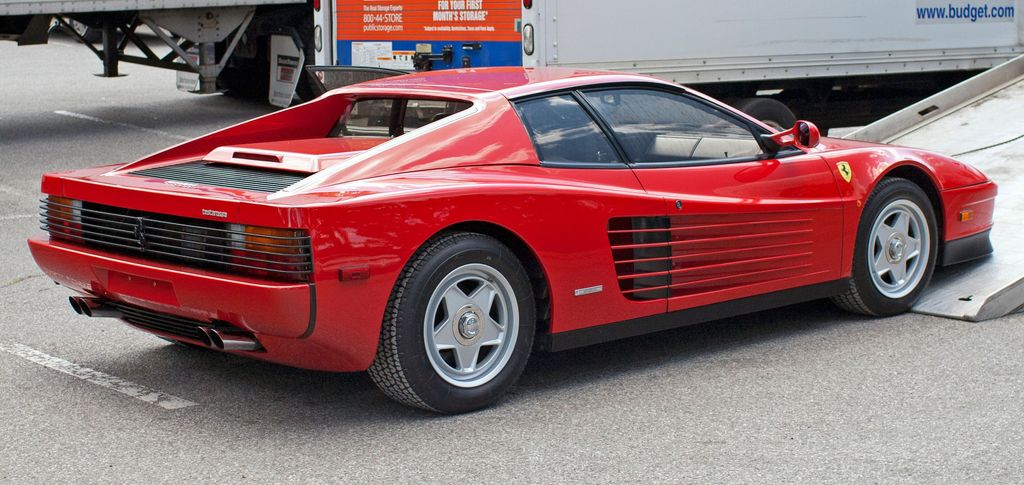
3. **Ferrari Testarossa**When you think of the Ferrari Testarossa, you immediately envision an icon of 80s supercar design – wide, low, and undeniably aggressive. Its retractable headlight design was a critical component of this persona, combining luxury with a truly commanding aesthetic. The Testarossa didn’t just look fast; it needed hidden lights to look even faster, enhancing its mystique and formidable road presence. These lights were more than functional; they were a statement.
The pop-up headlights allowed Ferrari’s designers to craft an ultra-low nose for the Testarossa, something that would have been impossible with traditional fixed headlights given the regulations of the time. This low profile contributed to the car’s sleek, wedge-like silhouette, a hallmark of supercar design. The ability to hide the lights maintained the clean, uninterrupted lines that were essential to its visual drama, giving it a powerful and almost predatory stance.
For a car that was all about excess and visual spectacle, the mechanical ballet of the pop-up headlights perfectly aligned with the Testarossa’s character. The moment those lights ascended, the car seemed to awaken, transforming its expression and asserting its dominance. This theatrical element was part of the allure, making the Testarossa a car that wasn’t just driven, but experienced in every sense.
Ferrari’s use of pop-ups on the Testarossa showcased how this design feature could be employed in high-end, exotic vehicles to achieve both an aggressive look and aerodynamic benefits. Even when closed, the design aimed to be as flush as possible, optimizing airflow across the vehicle. This blend of high-octane performance and unmistakable visual identity made the Testarossa a timeless symbol of the pop-up headlight era, a vehicle that still commands attention decades later.
Car Model Information: 1989 Ferrari Testarossa
Name: Ferrari Testarossa, 512 TR and F512 M
Manufacturer: Ferrari
Production: 1984–1996,9,939 produced
Assembly: Maranello
Predecessor: Ferrari Berlinetta Boxer
Class: Sports car,Grand tourer
BodyStyle: berlinetta
Layout: Rear mid-engine, rear-wheel-drive layout
Engine: Ferrari flat-12 engine,Flat-12 engine
Transmission: Manual transmission
Designer: Leonardo Fioravanti (engineer)
Categories: 1990s cars, All articles with dead external links, All articles with unsourced statements, Articles containing Latin-language text, Articles with dead external links from February 2018
Summary: The Ferrari Testarossa (Type F110) is a 12-cylinder mid-engine sports car manufactured by Ferrari, which went into production in 1984 as the successor to the Ferrari Berlinetta Boxer. The Pininfarina-designed car was originally produced from 1984 until 1991, with two model revisions following the end of Testarossa production called the 512 TR and F512 M, which were produced from 1992 until 1996. Including revised variations, almost 10,000 cars in total were produced, making it at the time one of the most mass-produced Ferrari models.
The Testarossa is a two-door coupé that premiered at the 1984 Paris Auto Show. All versions of the Testarossa were available with a rear-mounted, five-speed manual transmission. The rear mid-engine design (engine between the axles but behind the cabin) keeps the centre of gravity in the middle of the car, which increases stability and improves the car’s cornering ability, and thus results in a standing weight distribution of 40% front: 60% rear.
The original Testarossa was re-engineered for the 1992 model year and was introduced as the 512 TR (TR meaning TestaRossa), at the Los Angeles Auto Show, effectively as a completely new car, and an improved weight distribution of 41% front, 59% rear. Another new variant called the F512 M was introduced at the 1994 Paris Auto Show. The car dropped the TR initials and added the M which in Italian stood for modificata, or translated to modified, and was the final version of the Testarossa, which continued its predecessor’s weight distribution improvement of 42% front, 58% rear. The F512 M was Ferrari’s last vehicle that featured the flat-12 engine.
The Testarossa is a recognized cultural icon of the 1980s, and was popularized by media including the 1984 television series Miami Vice (from the 1986 season onward) and Sega’s 1986 video game Out Run.
Get more information about: Ferrari Testarossa
Buying a high-performing used car >>>
Brand: Ferrari Model: Testarossa
Price: $185,000 Mileage: 15,850 mi.
Read more about: Kings of the Asphalt: Reliving the Glory Days of 1980s Sports Cars and Supercars That Defined a Generation
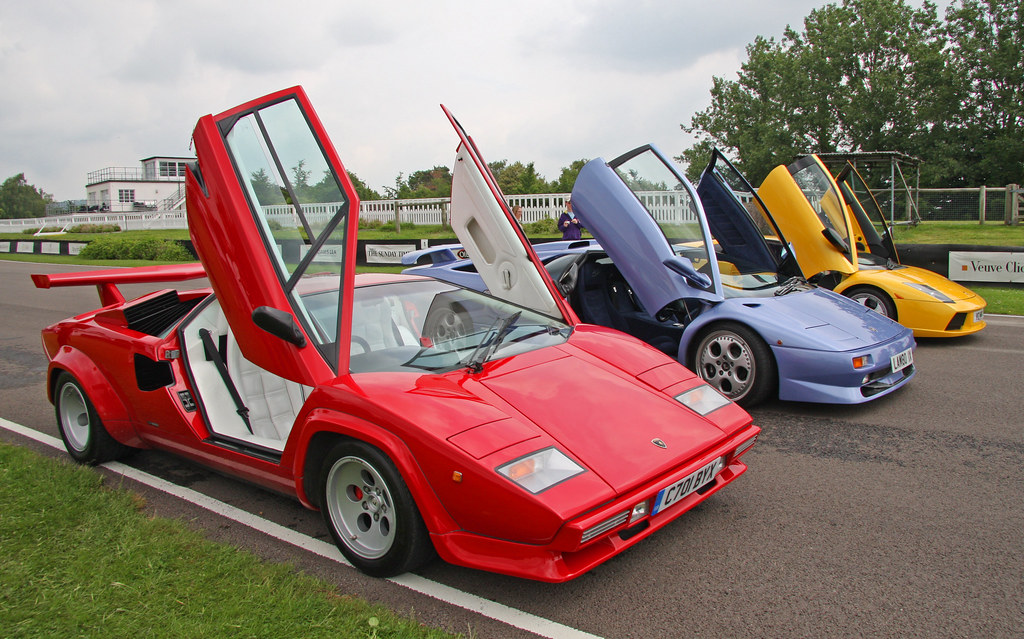
4. **Lamborghini Countach**The Lamborghini Countach, a vehicle that aggressively emphasized futuristic aesthetics, was arguably the epitome of the pop-up headlight era. Its design screamed sci-fi and rebellion, defining an entire era of automotive fantasy. The retractable headlights were not merely an addition; they were fundamental to the Countach’s outrageous, angular, and impossibly low profile, enabling designers to maintain sleek, low-profile front ends while still meeting headlight height regulations.
The Countach’s dramatic, wedge-shaped body was made possible, in part, by the ability to conceal its headlights. When tucked away, the car’s front end was an uninterrupted plane of exotic metal, giving it an almost alien appearance. This clean, smooth surface was crucial for conveying the car’s extreme, forward-thinking design philosophy, making it look as if it had just rolled off a spaceship, not a production line.
Activating the lights was a moment of pure spectacle. The slow, deliberate rise of the headlamps from the Countach’s hood added another layer of mechanical wonder to an already astounding machine. It was this kind of intricate, almost playful detail that contributed to the Countach’s larger-than-life personality, making it a dream car for a generation of enthusiasts and a symbol of audacious Italian design.
These models cemented pop-up headlights as a symbol of performance and style, making them highly desirable among car enthusiasts. The Lamborghini Countach, more than almost any other car, showcased how pop-ups could be integrated into an extreme design to create something truly unforgettable. It looked fast even when standing still, and the hidden lights only amplified that illusion of effortless speed and mystique.
Car Model Information: 1989 Lamborghini Countach 25th Anniversary
Name: Lamborghini Countach
Caption: Lamborghini Countach LP5000 QV
Manufacturer: Lamborghini
Production: 1974–1990
Assembly: Sant’Agata Bolognese
Designer: Marcello Gandini
Class: Sports car
BodyStyle: coupe
Layout: Longitudinal engine,mid-engine,rear-wheel-drive
Related: Lamborghini LM002
Engine: Lamborghini V12,V12 engine,LP400, LP400 S: {{cvt,3929,cc,L,1,disp=flip
Transmission: synchromesh,Manual transmission
Wheelbase: 96.46 in
Abbr: on (LP5000QV)
Order: flip
Length: 162.99 in
Width: LP 400: {{cvt,74.28,in,mm,0,abbr=on,order=flip
Height: 42.13 in
Weight: {{convert,1300.5,kg,lb,0,abbr=on
Predecessor: Lamborghini Miura
Successor: Lamborghini Diablo
Doors: Scissor doors
Sp: uk
Categories: 1980s cars, 1990s cars, All articles with unsourced statements, Articles containing Italian-language text, Articles containing Piedmontese-language text
Summary: The Lamborghini Countach ( KOON-tahsh) is a rear mid-engine, rear-wheel-drive sports car produced by the Italian automobile manufacturer Lamborghini from 1974 until 1990. It is one of the many exotic designs developed by Italian design house Bertone, which pioneered and popularized the sharply angled “Italian Wedge” shape.
The wedge style was introduced to the public in 1970 with the Lancia Stratos Zero concept car. The first showing of the Countach prototype was at the 1971 Geneva Motor Show, as the Lamborghini LP500 concept.
The “Countach” nameplate was reused for the Sián-based limited-production hybrid-electric model called the Countach LPI 800-4 in 2021.
Get more information about: Lamborghini Countach
Buying a high-performing used car >>>
Brand: Lamborghini Model: Countach
Price: Not Priced Mileage: 7,493 mi.
Read more about: Kings of the Asphalt: Reliving the Glory Days of 1980s Sports Cars and Supercars That Defined a Generation
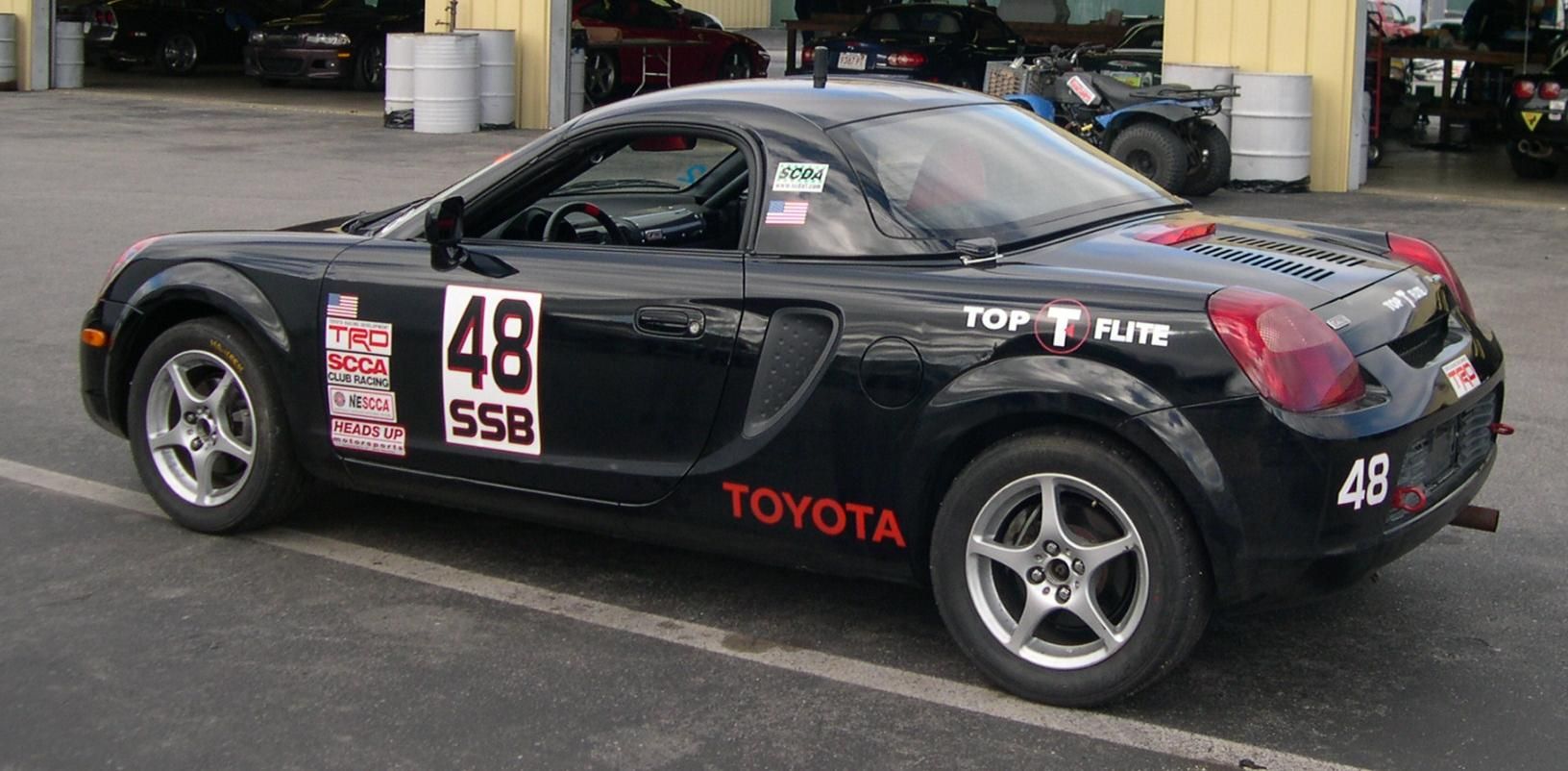
5. **Toyota MR2**The Toyota MR2 stands out as a prime example that pop-up headlights weren’t just for supercars but also graced lightweight sports cars, bringing that same cool factor to a more accessible package. The MR2, particularly its first and second generations, was lauded for its nimble handling and mid-engine layout, and its pop-up headlights played a significant role in its sleek and sporty aesthetic. This allowed Toyota to create a low, aerodynamic front end that complemented the car’s dynamic character.
The MR2’s design aimed for a clean, aerodynamic look, and its retractable headlights were key to achieving this. When the lights were down, the car presented a smooth, uncluttered nose that reduced drag, a benefit crucial for a lightweight sports car where every ounce of efficiency and performance was carefully considered. This design choice contributed to the MR2’s perception as a modern and agile machine, capable of swift maneuvers and responsive driving.
Beyond the practical benefits, the pop-ups gave the MR2 a playful and engaging personality. The way they popped up and down became a part of the car’s charm, endearing it to a legion of fans. It was a tangible piece of automotive theater that resonated with drivers who appreciated cars with a distinctive character, turning a simple night drive into a more interactive experience. The MR2 made the dream of owning a car with these distinctive lights a reality for many, proving their versatility across different market segments.
For many, the MR2 represented an era where car designs dared to be different and prioritized character alongside performance. The presence of pop-up headlights on such an iconic, yet more affordable, sports car broadened their appeal and ensured their legacy wasn’t confined solely to the realm of expensive exotics. It proved that personality and cutting-edge style could be found in a variety of vehicles, making the pop-up headlight a truly democratic cool feature.
Okay, so we’ve revelled in the glory days, soaking up the mechanical theatre and undeniable cool factor that pop-up headlights brought to some of automotive history’s most revered machines. We’ve seen them on everything from accessible sports cars to the most audacious supercars, proving that a little blink and flip could transform a vehicle into something truly special. But every golden age eventually faces its sunset, and for our beloved retractable lights, that sunset came rather abruptly, driven by forces far more pragmatic than pure aesthetic appeal—forces that forever changed the face of automotive design. Let’s dig into the cars that illustrate this dramatic shift.
Car Model Information: 1993 Toyota MR2 Turbo
Name: Toyota MR2
Caption: Second generation MR2
Manufacturer: Central Motors
Aka: Toyota MR (France and Belgium)
Production: 1984–2007
Assembly: Sagamihara, Kanagawa
Class: Sports car
Layout: Rear mid-engine, rear-wheel-drive layout
ModelYears: 1985–2007
Categories: 1990s cars, 2000s cars, All Wikipedia articles written in American English, All articles containing potentially dated statements, All articles needing additional references
Summary: The Toyota MR2 is a two-seater sports car which was manufactured and marketed by Toyota from 1984 until 2007 over three generations. It was the first Japanese rear-mid-engine, rear-wheel-drive production car and was sold around the world. The first generation (W10) was produced from 1984 to 1989, the second generation (W20) from 1989 to 1999, and the third generation (W30) from 1999 to 2007.
Conceived as a small, economical and sporty car, the MR2 features a straight-four engine, transversely mounted in front of the rear axle, four-wheel disc brakes, and fully independent coilover suspension with MacPherson struts on each wheel.
The name MR2 stands for either “mid-ship run-about 2-seater” or “mid-engine, rear-wheel-drive, 2-seater”. In French-speaking markets, the vehicle was renamed Toyota MR because the abbreviation “MR2” sounds like the profanity “merdeux” when spoken in French.
Get more information about: Toyota MR2
Buying a high-performing used car >>>
Brand: Toyota Model: MR2
Price: $21,499 Mileage: 145,631 mi.
Read more about: Kings of the Asphalt: Reliving the Glory Days of 1980s Sports Cars and Supercars That Defined a Generation
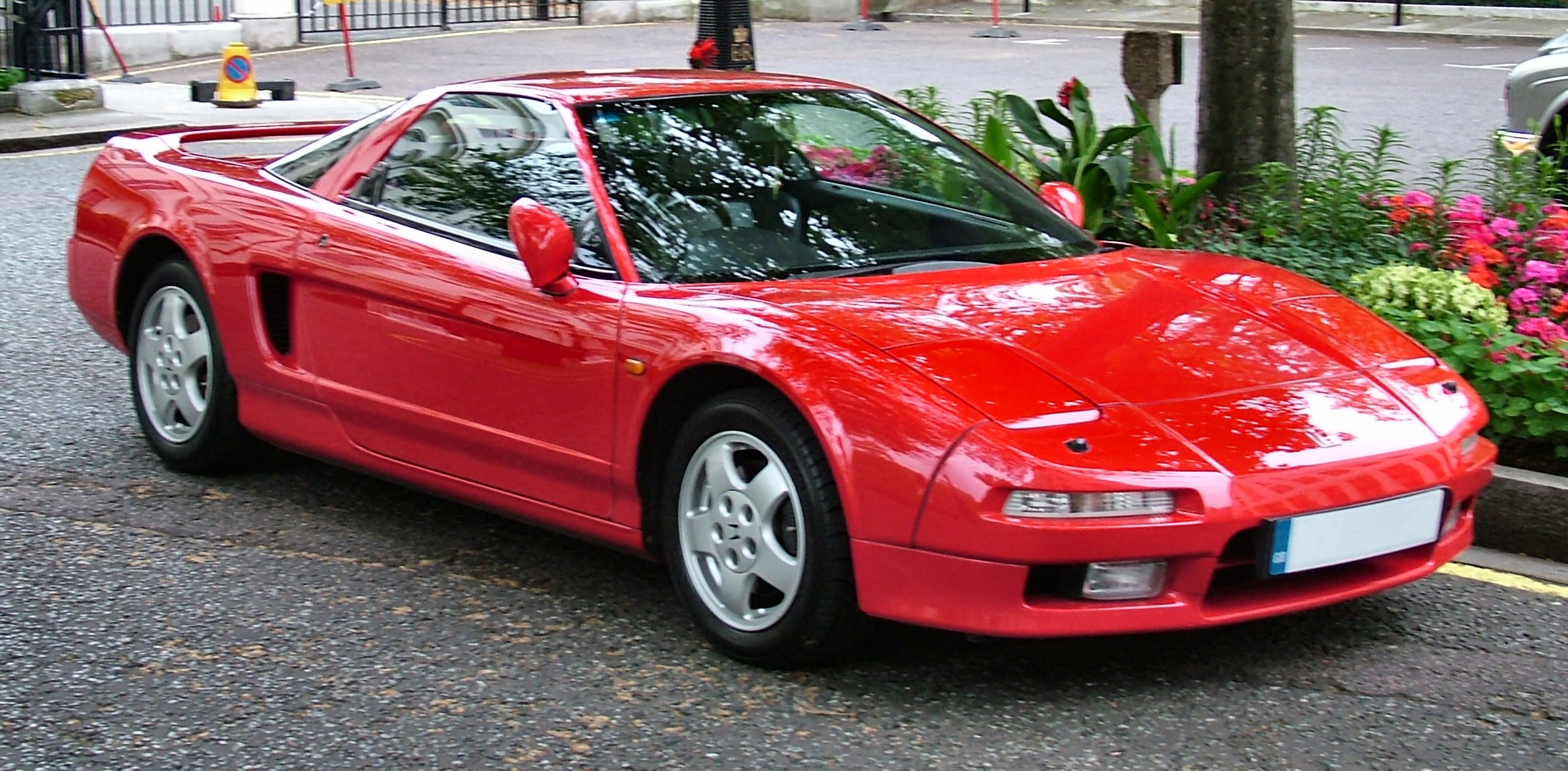
6. **Honda NSX**The Honda NSX, a supercar that redefined what a reliable, everyday exotic could be, masterfully incorporated pop-up headlights into its groundbreaking design. Launched in 1990, the NSX was an engineering marvel, boasting an all-aluminum monocoque chassis and a high-revving VTEC engine that made rivals like Ferrari scratch their heads. Its sleek, low-slung profile was absolutely integral to its performance philosophy, and the hidden headlights played a crucial role in achieving that seamless, aerodynamic aesthetic.
When tucked away, the NSX presented an incredibly smooth, uninterrupted front end, a design choice that wasn’t just about looking good—it was about cutting through the air with surgical precision. This aerodynamic purity helped the NSX achieve exceptional high-speed stability and efficiency, qualities that were central to its mission of challenging the European supercar elite on their own turf, but with Honda’s legendary reliability. The pop-ups allowed its designers to keep the nose incredibly low, contributing to a driving experience that felt utterly connected to the road, a testament to its “human-centered” design philosophy.
The NSX truly proved that pop-up headlights weren’t solely reserved for the outlandish excesses of European exotics; they could be integrated into a Japanese precision instrument designed for ultimate driver engagement. The deliberate, almost graceful rise of its lights added a subtle layer of sophistication to its already refined character, making it a standout in a market often dominated by more dramatic, sometimes less reliable, flair. It was cool, understated, and performance-oriented—a perfect embodiment of its era’s blend of technology and style.
However, even a car as forward-thinking and meticulously engineered as the NSX would eventually face the changing tides of automotive design and regulation. The later fixed-headlight redesigns, like the ones introduced with the 2002 facelift, were driven by evolving pedestrian safety regulations and the relentless pursuit of even greater aerodynamic efficiency, proving that even the most iconic pop-up designs eventually had to adapt. The NSX’s journey from pop-up pioneer to fixed-light evolution perfectly illustrates the dual pressures of design purity and pragmatic progress that ultimately shaped the entire industry. It was a shame to see them go, but it was a sign of the times.
Read more about: Remember These? 13 Rides That Went From Sought-After to Stale.
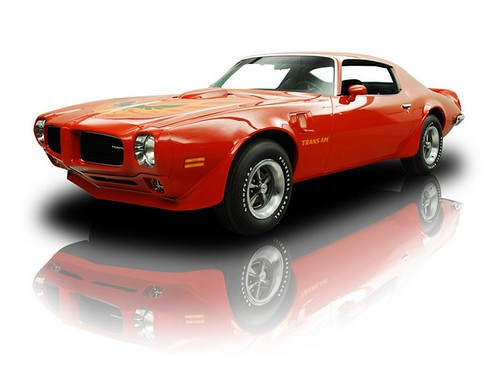
7. **Pontiac Firebird Trans Am**If there’s one car that truly epitomized the dramatic, in-your-face attitude of pop-up headlights in American culture, it has to be the Pontiac Firebird Trans Am. Specifically, the third and fourth generations, which strutted around with their distinctive hidden lamps, cementing their place as muscle car legends and bona fide TV stars. When you hear “Knight Rider,” you don’t just think KITT’s sardonic voice; you immediately envision those iconic, rectangular lights flipping up, ready for Michael Knight’s next high-octane adventure.
The Trans Am’s pop-ups weren’t just a mere stylistic flourish; they were an intrinsic part of its aggressive, aspirational image, allowing for that unmistakably sharp, wedge-like nose that became synonymous with performance and rebellious cool throughout the 80s and 90s. The theatrical movement of those lights, rising with a mechanical flourish to announce the car’s menacing presence, perfectly matched the Trans Am’s bold personality and its unashamed penchant for standing out in a crowded parking lot. It was a mechanical declaration of intent every single time you flicked on the switch.
For a generation, this car, with its hideaway lights and scream-for-attention styling, was the ultimate embodiment of automotive fantasy, a poster car for millions of gearheads. It had character in spades, and those pop-ups were a massive part of that allure, transforming the vehicle into something more than just transportation. They were part of the show, a defining detail that made the Trans Am feel like a living, breathing entity, full of hidden power and attitude. It was a statement car through and through, and its lighting system echoed that sentiment, giving it a playful, yet menacing, gaze.
But even a legend like the Trans Am, steeped in cultural lore, couldn’t escape the inevitable forces pushing against pop-up headlight designs. As safety regulations tightened across global markets, especially concerning pedestrian impact, the sharp edges and potentially hazardous protruding mechanisms of pop-up headlights became significant liabilities. The very feature that gave it so much personality eventually contributed to its demise. The urgent need for softer, energy-absorbing front ends meant that the days of the flip-up headlight, even on such an iconic American powerhouse, were sadly and irreversibly numbered. It was a tough pill for enthusiasts to swallow.
Car Model Information: 2023 Honda Civic EX
Name: Pontiac Firebird
Caption: The second, third, and fourth generations of,the Pontiac Firebird Trans Am
Manufacturer: Pontiac (automobile)
Production: February 23, 1967 – August 30, 2002
ModelYears: 1967 – 2002
Class: Pony car,Muscle car
Platform: GM F platform
Related: Chevrolet Camaro
Layout: Front engine, rear-wheel-drive layout
Categories: 1970s cars, 1980s cars, 1990s cars, 2000s cars, All articles with dead external links
Summary: The Pontiac Firebird is an American automobile built and produced by Pontiac from the 1967 to 2002 model years. Designed as a pony car to compete with the Ford Mustang, it was introduced on February 23, 1967, five months after GM’s Chevrolet division’s platform-sharing Camaro. This also coincided with the release of the 1967 Mercury Cougar, Ford’s upscale, platform-sharing version of the Mustang.
The name “Firebird” was also previously used by GM for the General Motors Firebird series of concept cars in the 1950s.
Get more information about: Pontiac Firebird
Buying a high-performing used car >>>
Brand: Pontiac Model: Firebird Trans Am
Price: $23,541 Mileage: 56,979 mi.
Read more about: Steering Clear of Danger: An In-Depth Look at 14 Vehicles with Concerning Safety Scores for Savvy Consumers

8. **Toyota Supra (Mk III & Mk IV)**The Toyota Supra, a name that resonates with high-performance JDM legends and tuners worldwide, also famously embraced pop-up headlights, particularly in its beloved Mk III generation. These cars were not just about powerful engines; they were meticulously engineered grand tourers designed for serious speed and track prowess, and the hidden headlights initially served both aesthetic and aerodynamic purposes, helping to craft a sleek and formidable presence on the road. The Supra was built to dominate, and its looks certainly played a part.
For the Mk III, the pop-ups contributed to a distinctly aggressive and aerodynamic silhouette, a crucial factor for a machine that was as much about high-speed cruising as it was about spirited canyon carving. When concealed, the Supra’s front end was a clean, uninterrupted expanse, minimizing drag and enhancing its already potent performance credentials. This design choice reinforced its image as a sophisticated, powerful machine, a true competitor to both European sports coupes and its domestic rivals. There was no mistaking its intent, even at a standstill.
However, the Supra’s journey with pop-ups also highlighted the inherent complexities and eventual drawbacks of the design, which foreshadowed their broader industry decline. While undeniably cool and full of mechanical charm, these intricate systems, like those on other pop-up equipped brethren, came with “an extra mechanical failure point in the headlights.” Owners could sometimes face frustrating issues with worn-out motors or misaligned linkages, leading to the dreaded “winking” effect of one light up and one down—a minor frustration, perhaps, but a reliability concern that became harder to justify as cars became more appliance-like.
By the time the utterly iconic Mk IV Supra debuted in 1993, Toyota had largely transitioned to fixed headlights, although some early international models still featured a more subtle, almost flush pop-up design. This rapid shift perfectly illustrates the broader industry trend: as engineering priorities moved towards greater simplicity, improved long-term reliability, and compliance with increasingly stringent global safety standards, the theatrical charm of pop-ups had to yield to more practical, less headache-inducing solutions. The Supra’s evolution reflected this changing automotive landscape, even as its performance continued to push boundaries.
Car Model Information: 2022 Toyota Supra 3.0 Premium
Name: Toyota Supra
Caption: Toyota GR Supra (J29/DB)
Manufacturer: Toyota
Aka: unbulleted list
Production: unbulleted list
Class: Sports car
BodyStyle: fastback,coupé
Layout: Front-engine, rear-wheel-drive layout
Predecessor: Toyota Celica (A20)
Categories: 1980s cars, 1990s cars, 2000s cars, 2010s cars, 2020s cars
Summary: The Toyota Supra (Japanese: トヨタ・スープラ, Hepburn: Toyota Sūpura) is a sports car and grand tourer manufactured and developed by the Toyota Motor Corporation beginning in 1978. The name “supra” is a definition from the Latin prefix, meaning “above”, “to surpass” or “go beyond”.
The initial four generations of the Supra were produced from 1978 to 2002. The fifth generation has been produced since March 2019 and later went on sale in May 2019. The styling of the original Supra was derived from the Toyota Celica, but it was longer. Starting in mid-1986, the A70 Supra became a separate model from the Celica. In turn, Toyota also stopped using the prefix Celica and named the car Supra. Owing to the similarity and past of the Celica’s name, it is frequently mistaken for the Supra, and vice versa. The first, second and third generations of the Supra were assembled at the Tahara plant in Tahara, Aichi, while the fourth generation was assembled at the Motomachi plant in Toyota City. The 5th generation of the Supra is assembled alongside the G29 BMW Z4 in Graz, Austria by Magna Steyr.
The Supra traces much of its roots back to the 2000GT owing to an inline-6 layout. The first three generations were offered with a direct descendant to the Crown’s and 2000GT’s M engine. Interior aspects were also similar, as was the chassis code “A”. Along with this name, Toyota also included its own logo for the Supra. It was derived from the original Celica logo, being blue instead of orange. This logo was used until January 1986, when the A70 Supra was introduced. The new logo was similar in size, with orange writing on a red background, but without the dragon design. That logo, in turn, was on Supras until 1991 when Toyota switched to its current oval company logo. The dragon logo was a Celica logo regardless of what colour it was. It appeared on the first two generations of the Supra because they were officially Toyota Celicas. The dragon logo was used for the Celica line until it was also discontinued.
In 1998, Toyota ceased sales of the fourth-generation Supra in the United States. Production of the fourth-generation Supra for worldwide markets ended in 2002. In January 2019, the fifth-generation Supra, which was co-developed with the G29 BMW Z4, was introduced.
Get more information about: Toyota Supra
Buying a high-performing used car >>>
Brand: Toyota Model: Supra
Price: $53,983 Mileage: 30,565 mi.
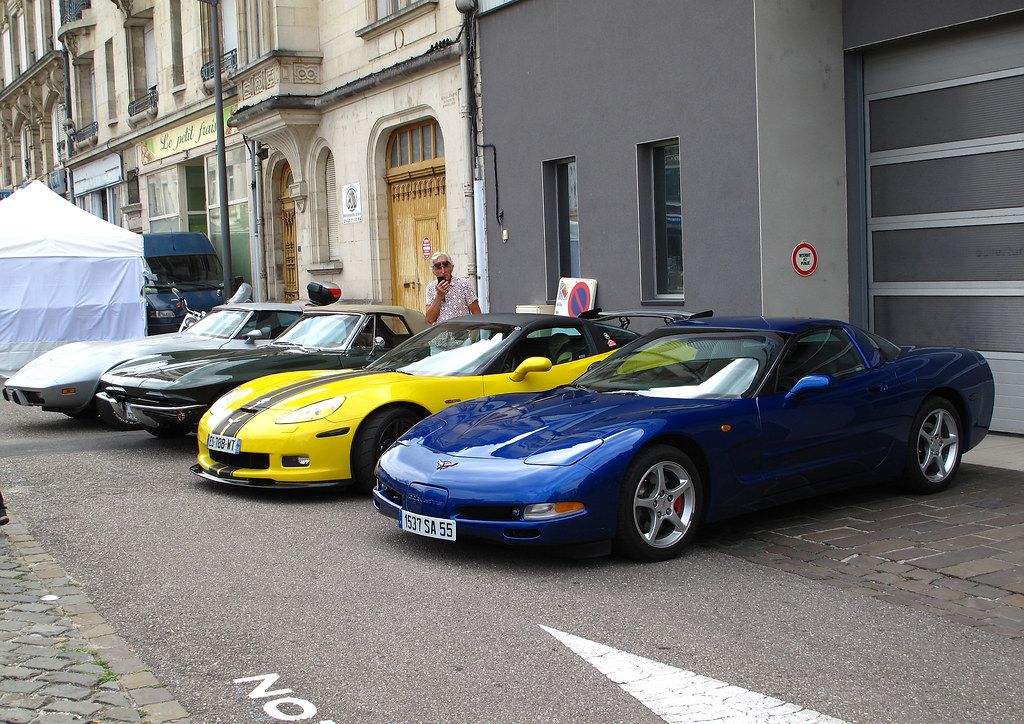
9. **Chevrolet Corvette C5**Ah, the Chevrolet Corvette C5 – a car that deserves a special, almost elegiac mention in the annals of pop-up headlight history. Not only was it an absolute powerhouse, refining the Corvette formula to perfection and offering astounding performance for the money, but it also earned the bittersweet distinction of being “The Last Car With Pop-Up Headlights” from a major manufacturer when production ceased in 2004. Its discontinuation truly marked the definitive end of an era, a final curtain call for this universally beloved design feature.
The C5, which burst onto the scene in 1997, proudly continued the Corvette tradition of a long, low hoodline and a powerful, athletic stance, and its pop-up headlights were a direct inheritance of that quintessential American sports car ethos. They allowed for a sleek, aerodynamic nose that looked absolutely incredible when the lights were tucked away, projecting an clean image of latent power and sophisticated grace. The distinctive way they’d rise from the body, almost like a pair of mechanical eyes slowly opening, gave the C5 a unique character, a final, emphatic wink to a bygone design philosophy that many enthusiasts adored.
But by the early 2000s, the writing was very much on the wall for pop-ups, and the C5 found itself battling against a relentless tide of evolving regulations and rapid technological advancements. Pedestrian safety laws, in particular, were becoming an insurmountable hurdle. The rigid, protruding nature of the pop-up mechanism, with its hard edges and potential for causing injury, simply didn’t align with the new requirements for “soft, energy-absorbing front ends,” making it increasingly difficult, complex, and costly to integrate them into new designs. Automakers were forced to make tough choices.
Furthermore, the C5, like its illustrious predecessors and other pop-up cars, wasn’t entirely immune to the notorious reliability quirks that plagued these intricate systems. As the context points out, earlier Corvettes were known for providing “an excuse for electrical gremlins,” and while the C5 was a significantly more refined and dependable machine, the inherent complexity of moving headlight assemblies remained a potential point of failure. This, combined with the industry-wide push for better aerodynamics from seamlessly flush-mounted, fixed lights and the revolutionary rise of compact, incredibly versatile LED technology, ultimately sealed the fate of the pop-up on the C5. It was a magnificent swan song, a final roar of defiance, but a swan song nonetheless.
Car Model Information: 2023 Honda Civic EX
Name: Chevrolet Corvette (C5)
Manufacturer: Chevrolet
Production: October 1, 1996 – July 2, 2004
ModelYears: 1997–2004
Assembly: Bowling Green, Kentucky
Designer: John Cafaro (1993)
Predecessor: Chevrolet Corvette (C4)
Successor: Chevrolet Corvette (C6)
Class: Sports car
BodyStyle: coupé,Convertible (car),hardtop
Layout: Front-engine, rear-wheel-drive layout#FMR
Platform: GM Y platform
Engine: General Motors LS-based small-block engine#LS1,General Motors LS-based small-block engine#LS6
Transmission: Manual transmission,Automatic transmission
Wheelbase: cvt
Length: cvt
Width: cvt
Height: {{cvt,47.7,in,mm,0
Weight: {{cvt,1472,kg,lb,0
Related: Callaway C12
Categories: 2000s cars, All articles with unsourced statements, Articles with short description, Articles with unsourced statements from August 2024, Articles with unsourced statements from March 2019
Summary: The Chevrolet Corvette (C5) is the fifth generation of the Corvette sports car, produced by the Chevrolet division of General Motors for the 1997 through 2004 model years. Production variants include the high performance Z06. Racing variants include the C5-R, a 24 Hours of Daytona and 24 Hours of Le Mans GTS/GT1 winner. The C5 Corvette was the first GM vehicle to feature the third generation small block “LS” engines. This was the last generation Corvette with Pop-up headlights.
Get more information about: Chevrolet Corvette (C5)
Buying a high-performing used car >>>
Brand: Chevrolet Model: Corvette C5
Price: $23,541 Mileage: 56,979 mi.
Read more about: Kings of the Asphalt: Reliving the Glory Days of 1980s Sports Cars and Supercars That Defined a Generation

10. **Ares Panther**Just when you thought pop-up headlights were consigned solely to the dusty realms of nostalgia and classic car shows, along comes the Ares Panther – a glorious, audacious anomaly that reminds us exactly what could be. This isn’t a mass-market comeback, mind you, nor a sign of a widespread trend, but rather a “limited-run, retro-modern supercar based on the De Tomaso Pantera,” and it proudly sports fully functional, undeniably cool retractable headlights. It’s an exquisitely expensive, hand-built nod to a legendary past, tailor-made for those who refuse to let the magic die.
The Ares Panther is not about setting new trends for mass production; it’s a “one-car tribute concert,” a bespoke masterpiece painstakingly designed to evoke the spirit of a bygone era with cutting-edge modern engineering. Its very existence is a powerful testament to the enduring appeal of pop-up headlights, proving that for a certain, highly discerning clientele, the sheer theatricality, the interactive charm, and the unique character these lights bring are worth every bespoke penny. It’s undeniably glorious, it looks like it “rolled off the Miami Vice set” and into a modern dream, and it is, at its heart, a pure passion project by Ares Design.
Ares Design understood the assignment perfectly: tap into that deep, almost primal desire for cars that have distinct personality, cars that don’t just blend anonymously into the automotive landscape. The Panther’s pop-ups are a deliberate, unapologetic stylistic choice, blissfully unburdened by the same crushing regulatory and cost pressures that hamstring mass-market vehicles. It operates in an exclusive, high-end niche where design bravado and emotional connection can absolutely take precedence over pedestrian safety regulations (presumably met through incredibly clever, albeit expensive, engineering) and the quest for micro-fractions of aerodynamic efficiency. This allows the beloved “blink and flip” to live again, albeit for the very wealthy and the deeply, deeply nostalgic.
This remarkable supercar, while emphatically not signalling a widespread “pop-up renaissance,” does offer a tantalizing glimmer of hope for how elements of this iconic design could potentially be reimagined in the future. It suggests that if safety regulations can indeed be met (likely through innovative, high-cost solutions that push engineering boundaries) and if the market is willing to pay the premium, the spirit of retractable lighting could endure in ultra-luxury, custom, or even concept forms. For now, it remains a solitary, dazzling beacon for pop-up devotees, a wistful yet thrilling reminder that some designs are just too cool, too full of character, to ever truly be forgotten.
Read more about: Sweet Sixteen Rides: Unveiling the Most Extravagant Cars Gifted to Celebrity Kids
So there you have it, folks. From the exhilarating spectacle of a Ferrari Testarossa’s lights rising to the final, poignant blink of a Corvette C5, pop-up headlights truly defined an era of automotive design that prioritized character and flair. They were quirky, they were bold, and they gave cars an undeniable personality that modern, integrated LED strips, for all their undeniable efficiency and sleekness, simply can’t replicate. While regulatory shifts, aerodynamic imperatives, and the relentless march of technology eventually pulled the plug on their widespread use, the memory of those winking, flipping eyes continues to spark joy and potent nostalgia among enthusiasts worldwide. They might be gone from mainstream production, but the unique character and mechanical charm they brought to our roads will forever remain etched in the heart of car culture. And who knows, in the ever-evolving world of automotive design, perhaps a new, safe, and truly innovative interpretation might one day allow our cars to wink at us once more, rekindling that mechanical magic for a new generation.

